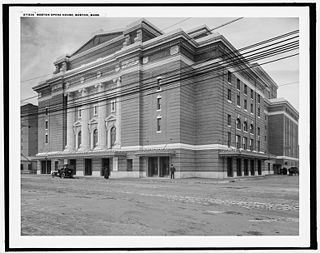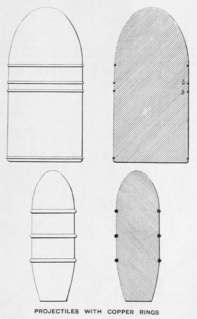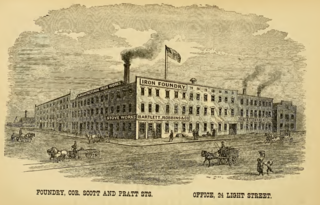
Colt's Manufacturing Company, LLC is an American firearms manufacturer, founded in 1855 by Samuel Colt and is now a subsidiary of Czech holding company Česká zbrojovka Group. It is the successor corporation to Colt's earlier firearms-making efforts, which started in 1836. Colt is known for the engineering, production, and marketing of firearms, most especially between the 1850s and World War I, when it was a dominating force in its industry and a seminal influence on manufacturing technology. Colt's earliest designs played a major role in the popularization of the revolver and the shift away from earlier single-shot pistols. Although Samuel Colt did not invent the revolver concept, his designs resulted in the first very successful ones.

Frederick William Lanchester LLD, Hon FRAeS, FRS, was an English polymath and engineer who made important contributions to automotive engineering and to aerodynamics, and co-invented the topic of operations research.
Leonard Porter Ayres was an American statistician. He played a central role in developing and analyzing large-scale statistical projects, especially for the Russell Sage Foundation. His best-known work dealt with comprehensive statistical studies of American casualties in the first and second world wars.

Charles Clarence Robert Orville Cummings was an American film and television actor known mainly for his roles in comedy films such as The Devil and Miss Jones (1941) and Princess O'Rourke (1943), but who was also effective in dramatic films, especially two of Alfred Hitchcock's thrillers, Saboteur (1942) and Dial M for Murder (1954). He received five Primetime Emmy Award nominations, and won the Primetime Emmy Award for Best Actor in a Single Performance in 1955. On February 8, 1960, he received two stars on the Hollywood Walk of Fame for his contributions to the motion picture and television industries, at 6816 Hollywood Boulevard and 1718 Vine Street.

Hannibal Ingalls Kimball was an American entrepreneur and important businessman in post-Civil War Atlanta, Georgia.
Pope Manufacturing Company was founded by Albert Augustus Pope around 1876 in Boston, Massachusetts, US and incorporated in Hartford, Connecticut in 1877. Manufacturing of bicycles began in 1878 in Hartford at the Weed Sewing Machine Company factory. Pope manufactured bicycles, motorcycles, and automobiles. From 1905 to 1913, Pope gradually consolidated manufacturing to the Westfield Mass plant. The main offices remained in Hartford. It ceased automobile production in 1915 and ceased motorcycle production in 1918. The company subsequently underwent a variety of changes in form, name and product lines through the intervening years. To this day, bicycles continue to be sold under the Columbia brand.

The L. S. Starrett Company is an American manufacturer of tools and instruments used by machinists, tool and die makers, and the construction industry. The company was founded by businessman and inventor Laroy Sunderland Starrett in 1880. The company patented such items as the sliding combination square, bench vises, and a shoe hook fastener. It makes precision steel rules and tapes, calipers, micrometers, and dial indicators, among others.

The Sneath Glass Company was an American manufacturer of glass and glassware. After a brief 1890s startup in Tiffin, Ohio, the Company moved to Hartford City, Indiana, to take advantage of the Indiana Gas Boom. The small city was enjoying the benefits of the boom, and could provide natural gas as an energy source for manufacturers. Sneath Glass was one of many glass manufacturers that moved to the region, and became Hartford City's second largest employer.

Lang Propellers was a British company that manufactured aircraft propellers. The company operated independently from 1913 to 1936.
John Roach & Sons was a major 19th-century American shipbuilding and manufacturing firm founded in 1864 by Irish-American immigrant John Roach. Between 1871 and 1885, the company was the largest shipbuilding firm in the United States, building more iron ships than its next two major competitors combined. It was also by far the largest contractor to the U.S. Navy during this period, and at its peak is said to have been the nation's largest employer behind the railroads.
Hornblower & Weeks was an investment banking and brokerage firm founded by Henry Hornblower and John W. Weeks in 1888. At its peak in the late 1970s, Hornblower ranked eighth among member firms of the New York Stock Exchange in number of retail offices, with 93 retail sales offices located in the United States and Europe.
A sally saw is a portable, mechanical, motorized saw.

The Boston Opera House was an opera house located on Huntington Avenue in Boston, Massachusetts. It opened in 1909 as the home of the Boston Opera Company and was demolished in 1958 after years of disuse.

W & J Galloway and Sons was a British manufacturer of steam engines and boilers based in Manchester, England. The firm was established in 1835 as a partnership of two brothers, William and John Galloway. The partnership expanded to encompass their sons and in 1889 it was restructured as a limited liability company. It ceased trading in 1932.

The Churchill Machine Tool Company Limited began as the manufacturing subsidiary of the machine tool importers Charles Churchill & Company Limited founded in the early 1900s by US-born Charles Churchill (1837–1916). Created out of the personal bankruptcy of Charles Churchill, the company developed to become one of the largest British importers of machine tools from the United States and a major manufacturer of such tools, initially under licence and later of its own development.

George Lauder Jr. was a Scottish industrialist. A trained mechanical engineer, Lauder was responsible for many of the technical advancements made in the steel industry during the Industrial Revolution including updates to both the Bessemer Process and coal washing machinery while also leading the use of steel in arms and defense.

Josiah Vavasseur was an English industrialist who founded Vavasseur and Co.. In 1883 the company merged with W.G. Armstrong and Company, and Vavasseur became a director of the firm. Late in life he adopted Cecil Fisher, only son of Admiral John Fisher, and the Fisher family inherited his fortune, including Kilverstone Hall.
William Andrew Hanley was an American mechanical engineer, business executive in Indianapolis, and 60th president of the American Society of Mechanical Engineers in 1940-1941.
Joseph Jenckes Sr., also spelled Jencks and Jenks, was a bladesmith, blacksmith, mechanic, and inventor who was instrumental in establishing the Saugus Iron Works in Massachusetts Bay Colony where he was granted the first machine patent in America.

Bartlett-Hayward Company was a metalworking foundry located in Baltimore, Maryland founded in 1837. The company engaged initially in the production of latrobe stoves, but by the end of the nineteenth century, its Pigtown complex was the largest iron foundry in the United States, with a diverse output including cast-iron architecture, steam heating equipment, machine parts, railroad engines and piston rings.











